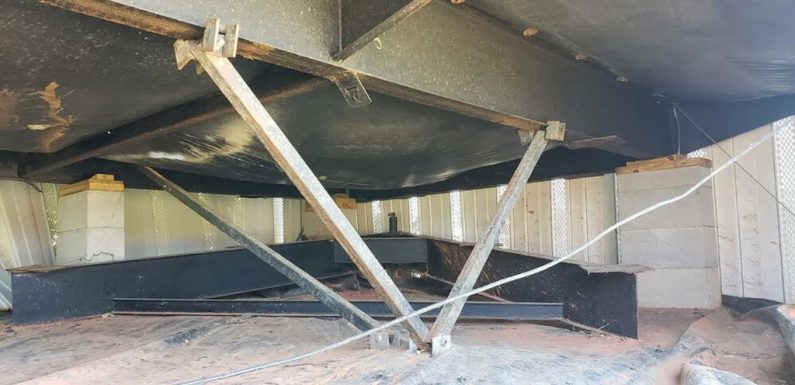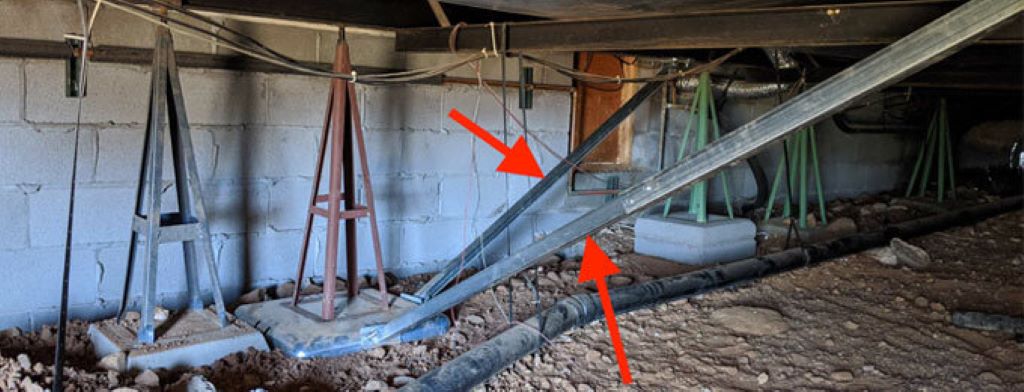
Making sure your mobile or manufactured home is properly secured with tie downs is incredibly important for your safety and peace of mind. Severe storms with high winds can cause major damage if your home isn’t strapped down correctly. That’s why local building codes and regulations exist for manufactured home tie downs and anchoring. These regulations provide the specifications, strength ratings, and installation methods you need to follow to keep your home stable in even the harshest weather conditions. Get up to speed on the tie down rules for your area with this comprehensive guide on mobile home tie down strapping.
Step 1: Researching Your Local Tie-Down Regulations
The first thing you need to do is find out the exact tie-down and anchoring regulations for manufactured homes in your county, city, town, or jurisdiction. These specifics will be based on building codes and land-use ordinances put in place by your local government.

Check with Your Municipal Building Department
The best place to start your research is by going straight to the source – your local municipal building department, construction services office, or code enforcement agency.
Call, email, or visit in person to inquire about the current regulations and code requirements regarding tie downs for manufactured homes installed within your jurisdiction.
Some key questions to have answered:
- What are the standards for tie down straps and anchor types?
- How many tie downs are required per linear foot?
- What are the specs for diagonal ties and frame ties?
- Do I need permits or inspections?
Having these details spelled out for your specific area is invaluable for ensuring full compliance.
Review HUD Standards on Tie Downs
In addition to local building codes, newly produced manufactured homes must meet federal standards regulated by the Department of Housing and Urban Development (HUD).
Ask your local building department how state and HUD standards are integrated into your municipal tie down regulations.
HUD lays out comprehensive guidelines for manufactured home installation in their Manufactured Home Installation Standards document (HUD-758).
Chapter 8 of this document focuses on tie downs specifically, with details on:
- Tie down configurations and spacing
- Requirements for ground anchors
- Specifications for straps and turnbuckles
- And more
Use this as a reference point even if your area hasn’t officially adopted these standards.
See Your Home Manufacturer Guidance
The company that built your manufactured home will also likely have instructions regarding properly securing the home to the ground.
Check your home’s manual or contact the manufacturer directly to ask for their official guidelines on tie down systems for that model, including:
- Recommended anchor types
- Suggested strap placements
- Any special stability considerations
Having their input can further guide your local tie down compliance.
Step 2: Meeting the Tie Down Minimum Requirements
While specific regulations will vary across jurisdictions, most will set minimum standards for key components of your manufactured home’s tie down system.
Being familiar with these broader codes can ensure your tie-downs are up to fundamental levels of quality and durability.
Minimum Strength Ratings
A core foundation of any municipal tie down standard is the minimum strength capacity required for the straps, anchors, and other parts securing the home.
The most common baseline is a minimum resistance of 4,800 pounds of force per individual tie down. This means each strap and anchor placed must independently be strong enough to withstand up to 4,800 pounds pulling against it without failing.
So if you have 10 ground anchors with tie down straps installed, the entire system must resist 48,000 pounds of pressure across all connection points before components would start to give way.
This strength rating ensures your home stays anchored even as extreme winds apply powerful uplift forces against the exterior walls, roof, and flooring.
Standards for Tie Down Straps
The straps connecting the frame to the ground anchors are typically made of galvanized steel for durability.
You’ll usually see the following specifications required:
- Minimum width of 1 1⁄4 inches
- At least 0.035 inches thick
- Galvanized coating inside and out
Wider straps spread forces more evenly and resist cutting or abrasion damage better. Thicker steel provides enhanced strength, while galvanization protects against long-term corrosion.
Proper strap protection where edges could cut in is also often mandated. Radius clips must be installed anywhere straps contact sharp frame or chassis components.
Specs for Anchors and Hardware
Anchors provide the fixed points in the ground, holding those tie-down straps steadily in place against the pulling forces.
Two common anchor types are:
In-Ground Earth Anchors: Auger-style anchors that dig deep into the soil using a screw tip. Required depth and design vary.
Concrete Deadmen: Solid concrete blocks buried underground that straps attach securely to. Must meet size and material standards to perform properly.
Your locality may permit other proprietary anchors to meet the same baseline capacity demands.
The connecting hardware is important, too. Turnbuckles should be heavy-duty steel able to handle up to 5,000 pounds or more. Solid welded eyes, clevises, and threaded connections must also withstand extreme stresses.
A properly installed tie down system with code-approved components anchors the home against wind and storms.
Proper Tie Down Placement
Exactly how many tie downs are needed and where they’re positioned on the home is another key element of regulated systems.
Some standard spacing and layout rules include:
- Tie downs every 8 to 10 linear feet around the home
- Extra tie downs near doors, openings, and wall ends
- Frame ties connecting to I-beams under the floor
- Diagonal ties across the roof and sidewalls
The goal is evenly distributing the load, anchoring potential weak points, and preventing rocking or overturning.
Placement mandates differ across regions depending on weather patterns so check your local guidelines.
Frame ties connect the steel chassis to anchors in the ground for critical stabilization.
Properly trained installers know how to strategically locate tie downs taking these variables into account.
Step 3: Installing Code-Compliant Tie Downs
Once you know your specific municipal regulations and have the mandated equipment, the installation process begins.
Proper setup of tie downs for manufactured homes requires careful planning and precision work. Know the following standards before attempting on your own or evaluating contractor services.
Permitting and Licensing Rules
Many areas regulate who can install and repair manufactured mobile home tie down strapping. See what qualifications or credentials are mandated in your region.
Permits from local building departments may also be necessary before altering your existing tie down configuration.
There also could be inspections needed before, during, or after the work, to verify compliance. Check requirements on permitting and inspections so this is not overlooked.

Manufacturer Equipment Guidelines
The company that built your actual home will have instructions on correctly installing the proprietary equipment they supply with it.
For example, the anchor manufacturer will have concrete deadmen sizing guidelines, soil type limits, and depth rules for their anchors you must follow.
Any variance from the product safety warnings, capacity labels, or instructions could make them fail inspection or perform below standards.
Professional Installation Best Practices
While you may legally be allowed to DIY mobile home tie down strapping work, complex regulations exist for good reason – to keep homes safe even in disasters.
Getting key elements wrong can put occupants and surrounding properties in danger if the home shifts or overturns.
That’s why hiring a certified installer following manufacturer guidelines and local codes to the letter is so important.
They have the expertise to:
- Select optimal anchor models
- Rig proper connections without damaging components
- Test pull-out resistance before finishing
- And document all work thoroughly
You simply want the peace of mind of it being done right. Don’t risk the consequences of preventable installation mistakes – leave it to the mobile home anchoring professionals whenever feasible.
Home Stability Starts from the Ground Up
Carefully engineered tie-downs might seem excessive when all is calm. But few will question their importance when high-velocity winds and storms strike.
Having your manufactured home properly strapped and anchored to the earth below gives critical reinforcement exactly when needed.
Staying on top of the municipal specifications, manufacturing directives, and qualified installation best practices guarantees your home remains stable through anything nature throws its way.
Protect your family and your property by securing those solid ties down to the ground below.
Frequently Asked Questions
Do existing mobile homes need to be retrofitted to meet new tie down regulations?
Typically no, unless you make certain modifications to the home that require permitting. But voluntarily bringing older tie downs up to current code is smart preparation as storms intensify over time.
Can I do annual inspections myself or do they require an official contractor?
You can inspect for any visible loosening, corrosion, or damage issues yourself in between formal inspections. However local codes often mandate using a qualified installer to document conditions at least once every few years officially.
I see ads for “tornado anchors” – are these approved for code compliance?
Specialty named anchors are usually just branding – the technical specifications meeting localized force ratings are what matters most. Confirm any retail products adhere to your area regulations before purchasing.
Can I use chains instead of steel straps for tie downs?
Building codes almost universally require wide, thick galvanized steel strapping instead of chains or cables. The distributed load capacity and longevity of steel straps far exceed other options.
My lot has solid bedrock subsurface – what anchor options can work?
In shallow bedrock areas, reinforced concrete deadmen anchors are likely the only viable regulatory-approved option for securing tie-downs. Soil depth and excavation requirements often prevent standard earth anchors from being feasible.
Final Thoughts
The bottom line is that properly installed tie-downs anchor your manufactured home to the ground, providing critical structural support against storms, flooding, earthquakes, and other threats.
But all tie down systems are not created equal. Local regulations exist to mandate strength ratings, durability, spacing, layouts and robust designs proven to withstand nature’s worst.
Discovering how to relax while working from home can be as important as mastering the process of researching, configuring, and installing code-compliant tie downs for your mobile home; whether you choose the hands-on approach of a DIY project or opt for the convenience of hiring professional installers, applying your newfound knowledge can bring a sense of calm to both your personal and housing endeavors.
Getting optimized strapping and anchoring fully adhering to your latest municipal specifications gives your home the best chance of surviving disasters fully intact.
And having the peace of mind that you’ve met code means you’ve done all you can to protect what matters most.

